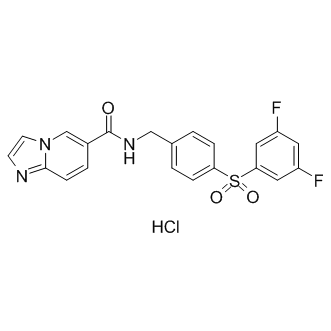GNE-617 hydrochloride |
| Catalog No.GC15967 |
NAMPT inhibitor, potent and competitive
Products are for research use only. Not for human use. We do not sell to patients.

Cas No.: 2070014-99-0
Sample solution is provided at 25 µL, 10mM.
GNE-617 hydrochloride is a potent and competitive inhibitor of nicotinamide phosphoribosyltransferase (NAMPT) with IC50 value of 5nM [1].
GNE-617 hydrochloride is a potent inhibitor of NAMPT. It reduces the NAD levels in a > 95% reduction in both NAPRT1-deficient and NAPRT1-proficient cell lines and exerts EC50 values ranging from 0.54nM to 4.69nM. In the invitro ADME assessments, GNE-617 hydrochloride shows the most optimal combination of in vitro metabolic stability, MDCK permeability and protein binding. Besides that, GNE-617 hydrochloride has potent antiproliferation effects on various cell lines. The IC50 values of it in U251, HT1080, PC3, MiaPaCa2 and HCT116 cell lines are 1.8nM, 2.1nM, 2.7nM, 7.4nM and 2nM, respectively. Moreover, GNE-617 hydrochloride also shows significant antitumor effects on U251 human glioblastoma tumor xenografts in mice and has no obvious effect on body weight loss [1, 2].
References:
[1] Zheng X, Bauer P, Baumeister T, et al. Structure-based discovery of novel amide-containing nicotinamide phosphoribosyltransferase (Nampt) inhibitors. Journal of medicinal chemistry, 2013, 56(16): 6413-6433.
[2] O'Brien T, Oeh J, Xiao Y, et al. Supplementation of Nicotinic Acid with NAMPT Inhibitors Results in Loss of In Vivo Efficacy in NAPRT1-Deficient Tumor Models. Neoplasia, 2013, 15(12): 1314-IN3.
Average Rating: 5 (Based on Reviews and 35 reference(s) in Google Scholar.)
GLPBIO products are for RESEARCH USE ONLY. Please make sure your review or question is research based.
Required fields are marked with *




















